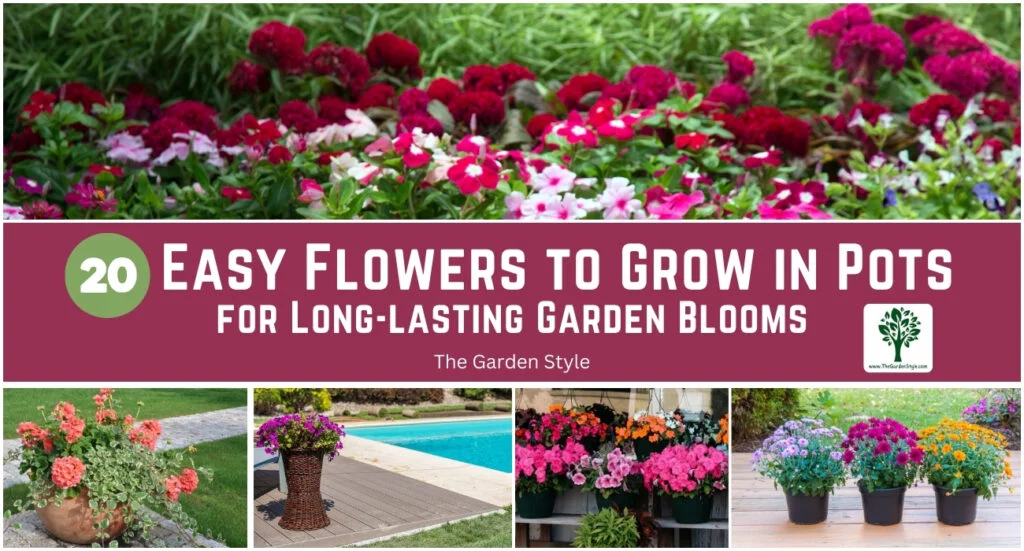Gardening is a therapeutic and rewarding hobby that can bring a touch of color and life to any living space. While some may think that having a traditional garden is necessary, growing flowers in pots can be just as fulfilling and accessible. In this article, we’ll explore the joys of container gardening and introduce you to some of the most beautiful and the 20 easiest flowers to grow in pots, annual and perennial flowers. Discover how to combine and arrange them in a full-sun or partial-shade garden to create a fantastic potted flower garden.
Table of Contents
Why Grow Flowers in Pots?
One of the biggest advantages of growing flowers in pots is the low maintenance required. Unlike in-ground gardens, potted plants have a contained root system, making them easier to water, fertilize, and manage.
Growing flowers in pots offers numerous advantages, especially for those with limited space or mobility. Pots are portable, allowing you to move them around to create different displays or follow the sun’s path. They’re also a great option for urban dwellers with balconies or small patios or for those who rent and can’t cultivate a traditional garden.


Benefits of Growing Flowers in Pots
Beyond their convenience, growing flowers in pots can be incredibly rewarding. If you have a small yard, balcony, or patio, growing flowers in pots is an excellent way to add vibrant colors and textures without taking up too much space. Pots come in various sizes so that you can find the perfect fit for your area.
Enjoy a burst of color and fragrance right outside your door, and nurturing your plants can be a soothing and therapeutic experience. Plus, potted flowers can attract pollinators like bees and butterflies, contributing to a healthier ecosystem.
Lastly, it’s a way to start cutting flowers, creating flower arrangements, and enjoying them indoors as well.
Annuals vs. Perennials: Which to Choose?
Annual flowers complete their life cycle within one growing season, while perennials return year after year. The choice between annuals and perennials depends on your gardening goals and commitment level. Annuals offer instant color and are perfect for seasonal displays, while perennials provide long-lasting beauty with minimal maintenance once established.
Full-Sun, Full/Partial-Shade Flower Options
Understanding the sunlight requirements of your selected flowers is essential for their overall health and vitality. Whether your outdoor space receives full sun, partial shade, or full shade, there are easy-to-grow flowers suited to thrive in each condition. Be mindful of the sunlight exposure in your garden area and choose flowers accordingly to ensure optimal growth.
Top 20 Easy Flowers to Grow in Pots
When it comes to selecting flowers for patio pots and planters, it’s essential to choose varieties that not only thrive in containers but also add color, fragrance, and visual interest to your outdoor space.
By the end of this section, you will find a chart that summarizes the best location to grow these annuals and perennial flowers in pots and planters. So, you can combine them properly regarding their watering and sunlight requirements.
Here are some of the best easy flowers to grow in pots and planters, outdoors, in a patio, garden, or small balcony:
Begonia

Begonias are shade-loving plants that thrive in patio pots in partially shaded areas. They come in various forms, including upright, trailing, and tuberous varieties, and offer a wide range of flower colors and foliage textures.
With their lush foliage and prolific blooms, begonias thrive in containers and add a splash of color to any patio.
- How and Where to Start Seeds: Indoors; can be transferred as seedlings.
- Soil Temperature: 70-75°F (21-24°C)
- Preferred Location: Semi-shaded to shaded; container gardening preferred.
- Light: Partial sunlight (4-6 hours daily).
- Expected Blooming: Summer to early autumn.
- Suggested Hardiness Zones: 6-11.
Calibrachoa (Million Bells)

Calibrachoas, often referred to as Million Bells, are compact, trailing plants that produce an abundance of small, bell-shaped flowers. They come in various colors and bloom profusely throughout the summer, adding a burst of color to your patio pots.
These prolific bloomers come in a rainbow of colors and perform well in both sun and partial shade, providing non-stop flowers throughout the season.
- How and Where to Start Seeds: Indoors; can be transferred as seedlings.
- Soil Temperature: 70-75°F (21-24°C)
- Preferred Location: Sunny to semi-shaded; container gardening preferred.
- Light: Full sunlight (6-8 hours daily).
- Expected Blooming: Spring to fall.
- Suggested Hardiness Zones: 9-11 as perennial, treated as annual in colder zones.
Cape Daisies (African Daisies)

Cape Daisies, whether annual or perennial, flourish in pots basking in full sun.
Cape Daisies, also known as African Daisies or Osteospermum, are cheerful annual or perennial flowers that originate from South Africa. They feature daisy-like blooms in shades of purple, white, pink, and yellow, with contrasting colored centers.
These sun-loving flowers are perfect for growing in pots and window boxes, as they thrive in full sun and well-draining soil. Cape Daisies are drought-tolerant and low-maintenance, making them an excellent choice for busy gardeners or those in hot, dry climates.
Most Cape Daisy varieties grow to a compact height of 8 to 12 inches, making them ideal for smaller containers. They bloom prolifically from spring to fall, providing months of colorful interest in your potted garden.
- How and Where to Start Seeds: Outdoors. Sow directly into the ground.
- Soil Temperature: 65-70°F (18-21°C)
- Preferred Location: Sunny; can be grown in containers or in-ground.
- Light: Full sunlight (6-8 hours daily).
- Expected Blooming: Late spring to early summer.
- Suggested Hardiness Zones: 9-11.
China Asters

China Asters are beautiful annual flowers that make excellent additions to container gardens. They produce stunning, full blooms in a wide range of colors, including pink, purple, red, white, and blue.
China Asters are relatively low-maintenance, making them ideal for beginner gardeners. They thrive in full sun and well-draining soil. Depending on the variety, they grow to a height of 1 to 3 feet, and their upright, branching habit creates a lovely display in pots and planters.
They bloom from late summer to fall, providing a vibrant pop of color when many other flowers are fading. I recommend deadheading regularly to encourage more blooms throughout the season.
- How and Where to Start Seeds: Indoors; can be transferred as seedlings.
- Soil Temperature: 65-75°F (18-24°C)
- Preferred Location: Sunny; can be grown in containers or in-ground.
- Light: Full sunlight (6-8 hours daily).
- Expected Blooming: Summer to early fall.
- Suggested Hardiness Zones: 2-11.
Cornflowers

Cornflowers (Centaurea cyanus) are charming annual flowers, also known as bachelor’s buttons. They are a cool-season delight for patio pots and thrive in full sun exposure and well-draining soil, blooming prolifically with their vibrant blue, pink, or white fringed petals.
While they prefer cooler temperatures in spring and fall, cornflowers make excellent cut flowers and readily self-sow for future seasons. Allow the soil to dry slightly between waterings and deadhead spent blooms to encourage further flowering and prevent excessive reseeding. With their upright growth habit and airy texture, Cornflowers add a touch of cottage garden whimsy to outdoor containers.
If you are looking for perennial cornflower varieties, then Centaurea montana is the perfect choice for growing in pots.
- How and Where to Start Seeds: Outdoors. Sow directly into the ground.
- Soil Temperature: 60-70°F (16-21°C)
- Preferred Location: Sunny; can be grown in containers or in-ground.
- Light: Full sunlight (6-8 hours daily).
- Expected Blooming: Late spring to early summer.
- Suggested Hardiness Zones: 2-11.
Recommended reading: Bachelor’s Button: Cornflowers Planting Guide from Seeds
Cosmos

Cosmos are known for their delicate, daisy-like blooms that come in shades of pink, white, and burgundy. These annual flowers are incredibly easy to grow from seed and make excellent cut flowers for bouquets.
For container gardening, consider the cosmos variety “Cosmos Dwarf Sensation” (or “Cosmos Sensation”) and “Cosmic Orange”, which are perfect for pots and planters.
Cosmos flowers thrive in full sun and well-draining soil. Once established, they are relatively drought-tolerant, making them a low-maintenance choice for potted gardens. Deadheading spent blooms will encourage continuous flowering throughout the summer and fall.
- How and Where to Start Seeds: Outdoors. Sow directly into the ground.
- Soil Temperature: 60-70°F (16-21°C)
- Preferred Location: Sunny; can be grown in containers or in-ground.
- Light: Full sunlight (6-8 hours daily).
- Expected Blooming: Summer to fall.
- Suggested Hardiness Zones: 2-11.
Forget-Me-Nots

Forget-Me-Nots are delightful little perennial flowers that thrive in partial shade conditions. Their clusters of dainty, sky-blue blossoms add a whisper of color to shaded areas of your potted garden. These low-growing plants make excellent additions to hanging baskets, window boxes, or shade containers.
Forget-Me-Not flowers prefer consistently moist, well-draining soil and bloom heavily in the spring, with the potential for additional flushes of flowers throughout the season. Their charming blooms and ability to self-sow make them a beloved choice for shady nooks.
- How and Where to Start Seeds: Indoors; can be transferred as seedlings.
- Soil Temperature: 60-65°F (16-18°C)
- Preferred Location: Partial shade to shaded; can be grown in containers or in-ground.
- Light: Partial sunlight (3-6 hours daily).
- Expected Blooming: Spring to early summer.
- Suggested Hardiness Zones: 3-9.
Geraniums

Geraniums are classic patio pot plants known for their vibrant blooms and aromatic foliage. These versatile plants come in a variety of colors, including red, pink, white, and salmon. They thrive in containers and provide continuous blooms from spring to fall, attracting butterflies and hummingbirds to your patio.
Geraniums thrive in sunny locations and are remarkably low-maintenance, making them ideal for those who sometimes forget to water their containers.
- How and Where to Start Seeds: Indoors; can be transferred as seedlings. However, Geraniums may be the easiest flower to propagate from cuttings during spring. So, you may prefer to grow them from cuttings.
- Soil Temperature: 70-75°F (21-24°C)
- Preferred Location: Sunny; can be grown in containers or in-ground.
- Light: Full sunlight (6-8 hours daily) to partial shade.
- Expected Blooming: Spring to fall.
- Suggested Hardiness Zones: 9-11.
Geraniums are perennial plants but annuals in some locations. If you can overwinter them in pots inside the house, they will thrive the next season.





Recommended reading: How to Care for Potted Geraniums – Easy Guide
Hydrangeas

While many flowers on the list can be easily grown from seeds, it’s advisable to refrain from starting hydrangeas from seeds. The easy-to-care-for varieties are typically sold as small potted plants rather than being available from seeds. So, varieties like the Endless Summer Hydrangeas (modified Hydrangea macrophylla) adapt well to growing in larger pots or planters, as they don’t get as large as some macrophylla types.
Keys to success with Hydrangeas in pots are using a well-draining potting mix, consistent moisture, and ensuring the roots don’t become overly pot-bound by repotting into a larger container every few years. They need consistent moisture and do best with morning sun and afternoon shade. With the right potting mix and annual pruning, hydrangeas can thrive and produce stunning blooms in patio containers.
- How and Where to Start Seeds: Indoors; can be transferred as seedlings.
- Soil Temperature: 65-75°F (18-24°C)
- Preferred Location: Partial shade; in-ground planting preferred.
- Light: Partial sunlight (3-6 hours daily).
- Expected Blooming: Late spring to summer.
- Suggested Hardiness Zones: 3-9.
Recommended reading: What to Plant with Hydrangeas (Companion Plant Guide)
Impatiens

If you have a shaded patio, balcony, or garden, Impatiens are an annual must-grow. These cheerful flowers come in a wide range of colors and bloom continuously throughout the season, providing a burst of color in areas with little direct sunlight.
Certain perennial varieties, such as New Guinea impatiens, have the potential to return annually if cultivated in appropriate climates, typically found in USDA zones 10 and 11.
- How and Where to Start Seeds: Indoors; can be transferred as seedlings.
- Soil Temperature: 70-75°F (21-24°C)
- Preferred Location: Partial shade to full-shade; container gardening preferred.
- Light: Partial sunlight (3-6 hours daily).
- Expected Blooming: Summer to fall.
- Suggested Hardiness Zones: 10-11.
Lantanas

Lantanas are heat-tolerant plants with clusters of colorful flowers that attract butterflies and bees. They come in a range of colors, including yellow, orange, pink, and purple, and thrive in sunny locations, making them perfect for patio pots.
They thrive in full sun and heat, making them perfect for pots on sunny patios or decks. Once established, they are drought-tolerant and produce clusters of vibrant flowers in shades of yellow, orange, red, pink, and multi-colors. Lantanas bloom continuously throughout the summer.
- How and Where to Start Seeds: Indoors; can be transferred as seedlings.
- Soil Temperature: 70-75°F (21-24°C)
- Preferred Location: Sunny; can be grown in containers or in-ground.
- Light: Full sunlight (6-8 hours daily).
- Expected Blooming: Late spring to fall.
- Suggested Hardiness Zones: 8-11.
Recommended reading: How to Propagate Lantana – Guide
Marigolds and Dwarf Marigolds

Marigolds are the epitome of easy-care patio pot flowers. They thrive in full sun, are resistant to pests and diseases, and produce an abundance of bright orange or yellow blooms throughout the summer and into fall. Dwarf marigolds are compact plants with cheerful, daisy-like blooms in shades of yellow, orange, and red. They are easy to grow, tolerate heat and drought, and add a pop of color to patio pots throughout the summer.
- How and Where to Start Seeds: Indoors; can be transferred as seedlings.
- Soil Temperature: 70-75°F (21-24°C)
- Preferred Location: Sunny; can be grown in containers or in-ground.
- Light: Full sunlight (6-8 hours daily).
- Expected Blooming: Summer to fall.
- Suggested Hardiness Zones: 2-11.
Recommended reading: How to grow Marigolds
Pansies

Pansies are a cool-weather favorite, adding a cheerful touch to garden pots in spring and fall. Their friendly “faces” come in a wide array of colors and patterns, and they perform well in both sun and partial shade.
- How and Where to Start Seeds: Indoors; can be transferred as seedlings.
- Soil Temperature: 60-70°F (16-21°C)
- Preferred Location: Partial shade to shaded; container gardening preferred.
- Light: Partial sunlight (3-6 hours daily).
- Expected Blooming: Spring to early summer.
- Suggested Hardiness Zones: 4-8.
Recommended reading: How to Plant Pansies – Quick Guide
Petunias

Petunias are classic choices for patio pots, offering a wide range of colors and bloom sizes. They are easy to grow, bloom prolifically throughout the summer, and trail beautifully over the edges of pots, creating a cascading effect.
These sun-loving annuals come in a stunning range of colors, from bright solids to delicate patterns, and bloom continuously from spring until the first frost.
- How and Where to Start Seeds: Indoors; can be transferred as seedlings.
- Soil Temperature: 70-75°F (21-24°C)
- Preferred Location: Sunny; can be grown in containers or in-ground.
- Light: Full sunlight (6-8 hours daily).
- Expected Blooming: Late spring to fall.
- Suggested Hardiness Zones: 9-11.
Portulaca (Moss Rose)

Portulaca, also known as moss rose, is a succulent-like annual that thrives in hot, sunny conditions and is remarkably drought-tolerant. Its vibrant blooms and spreading habit make it an excellent choice for spilling over the edges of patio pots.
- How and Where to Start Seeds: Outdoors. Sow directly into the ground.
- Soil Temperature: 70-80°F (21-27°C)
- Preferred Location: Sunny; can be grown in containers or in-ground.
- Light: Full sunlight (6-8 hours daily).
- Expected Blooming: Summer to fall.
- Suggested Hardiness Zones: 2-11.
Shirley and Red Corn Poppies

Shirley and Red Corn Poppies are elegant annual flowers with delicate, tissue-paper petals in shades of pink, red, white, and sometimes with hints of purple. While they prefer full sun, Shirley Poppies and Red Corn Poppies can also tolerate partial shade, making them suitable for a shade garden or outdoor containers with dappled light. Their ferny foliage and airy blooms add lovely texture to mixed planters.
Red corn poppies typically have solid red flowers. Shirley poppies have a wider range of colors, including bi-colors and picotee patterns and more delicate, tissue paper-like petals.
Shirley and Red Corn Poppies self-sow readily and require well-draining soil to prevent issues like root rot. With little maintenance beyond deadheading, these ephemeral beauties provide a burst of color in partially shaded areas.
- How and Where to Start Seeds: Outdoors. Sow directly into the ground.
- Soil Temperature: 60-65°F (16-18°C)
- Preferred Location: Sunny; can be grown in containers or in-ground.
- Light: Full sunlight (6-8 hours daily).
- Expected Blooming: Late spring to early summer.
- Suggested Hardiness Zones: 3-9.
Recommended reading: How to Grow California Poppies
Snapdragons

Snapdragons are beloved for their unique, dragon-like blooms that come in a variety of colors, including red, yellow, pink, and white. These cool-weather annuals are perfect for adding height and interest to potted displays.
A full-sun to partial shade garden location is perfect for Snapdragons. They’re relatively low-maintenance. Once established, they are relatively drought-tolerant but may benefit from regular watering during hot, dry periods. Removing faded flowers will promote ongoing blooming throughout the entire growing period.
- How and Where to Start Seeds: Indoors; can be transferred as seedlings.
- Soil Temperature: 65-75°F (18-24°C)
- Preferred Location: Partial shade to full sun; container gardening or in-ground planting.
- Light: Partial to full sunlight (3-8 hours daily).
- Expected Blooming: Late spring to early summer.
- Suggested Hardiness Zones: 4-10.
Recommended readings: How to Propagate Snapdragons Step by Step and Snapdragons Care Guide (Antirrhinum majus)
Sunflowers

While dwarf sunflowers may seem like an unlikely candidate for container gardening, they can thrive in pots and add a touch of cheerfulness to your outdoor space. Popular dwarf sunflower varieties are “Sunbright” and “Smile,” which are suitable for patio pots or larger planters.
When growing sunflowers in pots, choose a container at least 12 inches wide and deep to accommodate their sturdy root systems. Sunflowers require full sun exposure and well-draining soil. Regular watering and fertilizing will encourage abundant blooming.
- How and Where to Start Seeds: Outdoors. Sow directly into the ground.
- Soil Temperature: 70-85°F (21-29°C)
- Preferred Location: Sunny; in-ground planting preferred.
- Light: Full sunlight (6-8 hours daily).
- Expected Blooming: Summer to fall.
- Suggested Hardiness Zones: 2-11.
Recommended reading: How to Plant Sunflower Seeds
Verbenas

Verbena is another excellent choice for patio pots. Its clusters of tiny flowers are vibrantly hued pink, purple, blue, and white. Verbena is a heat-tolerant plant that thrives in sunny locations and attracts pollinators like butterflies and bees.
Verbenas are low-maintenance, heat and drought-tolerant once established. Deadheading spent blooms encourage more flowers.
- How and Where to Start Seeds: Indoors; can be transferred as seedlings.
- Soil Temperature: 70-75°F (21-24°C)
- Preferred Location: Sunny; can be grown in containers or in-ground.
- Light: Full sunlight (6-8 hours daily).
- Expected Blooming: Spring to fall.
- Suggested Hardiness Zones: 7-10.
Zinnias

Zinnias are one of the easiest flowers to grow from seed, making them a budget-friendly option for patio pots. These sun-loving annuals come in a kaleidoscope of colors and bloom prolifically throughout the summer months.
- How and Where to Start Seeds: Outdoors. Sow directly into the ground.
- Soil Temperature: 70-80°F (21-27°C)
- Preferred Location: Sunny; can be grown in containers or in-ground.
- Light: Full sunlight (6-8 hours daily).
- Expected Blooming: Summer to fall.
- Suggested Hardiness Zones: 2-11.
Recommended reading: How to Plant Zinnias from Seeds
These are just a few examples of the best flowers for outdoor pots and planters, each bringing its unique charm and beauty to your outdoor living space.
Easiest Annual and Perennial Flowers to Grow in Pots (Chart)
Here are some of the easiest flowers to grow and how to arrange them for a perfect flower pot design. Keep in mind that some perennial flower varieties may grow as annual plants in your area.
| Flower | Perennial/Annual | Sunlight Preference | Watering Needs | Notes | Other Care Tips | Days to Bloom from Seed |
| Begonia | Annual/Perennial | Partial Shade to Full Shade | Keep Moist | Excellent for containers | Deadhead spent blooms | 60-90 days |
| Calibrachoa (Million Bells) | Annual | Full Sun to Partial Shade | Moderate | Trailing habit, long bloomer | Pinch tips to promote bushiness | 55-70 days |
| Cape Daisy | Annual/Perennial | Full Sun | Drought Tolerant | Cheerful daisy-like blooms | Deadhead spent blooms | 70-90 days |
| China Aster | Annual | Full Sun | Moderate | Prune annually, use a large pot | Provide support for tall varieties | 90-120 days |
| Cornflower (Centaurea cyanus) | Annual | Full Sun | Moderate, Well-Draining Soil | Self-sows readily, cool season | Deadhead to prolong blooming | 60-90 days |
| Cosmos | Annual | Full Sun | Low | Delicate blooms, easy from seed | Stake tall varieties | 60-80 days |
| Forget-Me-Not | Perennial | Partial Shade | Consistent Moisture | Delicate blue blooms | Self-sows readily | 90-120 days |
| Geranium | Annual/Perennial | Full Sun to Partial Shade | Moderate | Long blooming period | Pinch tips for bushier growth | 70-90 days |
| Hydrangea | Perennial Shrub | Morning Sun, Afternoon Shade | Consistent Moisture | Prune annually, use large pot | Provide support for heavy blooms | 120-180 days (*) |
| Impatiens | Annual | Partial to Full Shade | Keep Moist | Great for shady areas | Deadhead spent blooms | 55-70 days |
| Lantana | Annual/Perennial | Full Sun | Drought Tolerant once Established | Vibrant colors, heat lover | Prune to maintain shape | 60-90 days |
| Marigold | Annual | Full Sun | Moderate | Low maintenance, pest resistant | Deadhead spent blooms | 45-60 days |
| Pansy | Annual | Full Sun to Partial Shade | Moderate | Prolific bloomer with many colors | Deadhead spent blooms | 70-90 days |
| Petunia | Annual | Full Sun | Moderate | Cool-weather favorite | Deadhead to promote more blooms | 60-90 days |
| Portulaca (Moss Rose) | Annual | Full Sun | Drought Tolerant | Prolific bloomer, drought-tolerant | Avoid overwatering | 60-80 days |
| Shirley and Red Corn Poppies | Annual | Partial Shade | Moderate, Well-Draining | Delicate tissue paper blooms | Allow to self-sow | 60-90 days |
| Snapdragon | Annual | Full Sun to Partial Shade | Moderate | Unique dragon-like blooms | Provide support, deadhead | 80-120 days |
| Sunflower (Dwarf) | Annual | Full Sun | Moderate | Compact varieties for pots | Provide support for large blooms | 60-80 days |
| Verbena | Annual/Perennial | Full Sun | Moderate, Well-Draining | Prolific bloomer, drought-tolerant | Prune to promote bushiness | 70-90 days |
| Zinnia | Annual | Full Sun | Moderate | Easy to grow from seed | Deadhead to extend bloom period | 55-70 days |
Save a pin for later! You can quickly return to the easy flowers to grow in pots (THE Chart!)
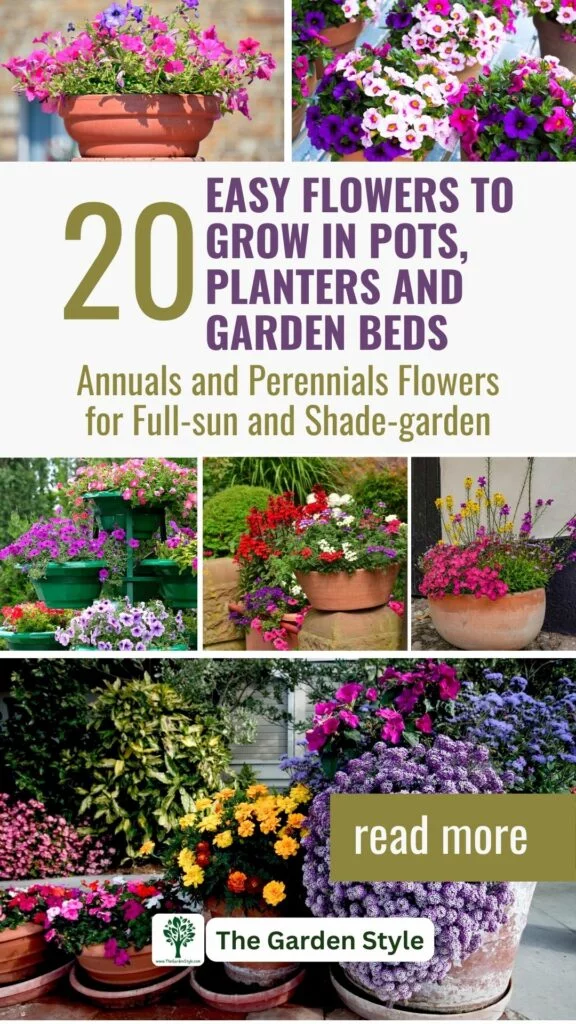
Arranging Flowers for a Perfect Flower Pot Design: Full-Sun vs. Shade Garden
For me, one of the most important things when combining flowers in pots and planters is their similar growing requirements, such as similar soil pH, watering schedule, nutrients, etc. Therefore, if you know the right combinations and how to arrange them, you can fail in your flower pot design!

Grouping plants with similar growing requirements, such as soil pH, watering needs, and nutrient requirements, is crucial for creating successful and thriving outdoor potted gardens. Additionally, considering the blooming times and sunlight preferences can help create visually appealing and harmonious arrangements.
I encourage you to come back to the previous table that summarizes key features you should consider when sowing seeds or planting flowers in a garden container. Those 20 are some of the easy flowers to grow in pots outdoors, but also easy to maintain. The key to success is to combine them properly according to their requirements. You don’t want to change your pots’ location in the morning and the afternoon. So, for the same pot, choose flowers with similar sunlight requirements and watering needs (at least those two conditions).
Full-Sun Flowers to Grow in Pots
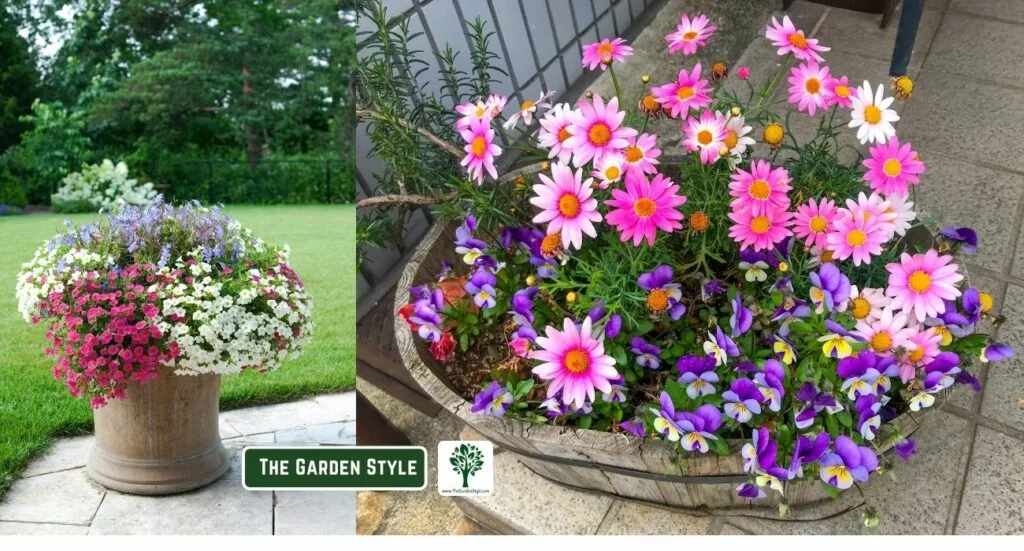
Here is a combination of easy flowers to grow that thrive in full-sun conditions with low to moderate watering needs that you can easily combine on the same container (or garden in-ground).
- Cape Daisy
- China Aster
- Cosmos
- Marigolds
- Zinnias
- Dwarf Petunias
What I like the most about these combinations is that Petunias are relatively short in height, making them suitable for combining with taller flowers such as Cosmos, Marigolds, and Zinnias in a pot placed in a full-sun garden. Dwarf petunias can easily grow and create a cascade of flowers, making them ideal also for hanging pots. These are my 5 favorite flowers that are easy to grow in pots from seeds for a full sun garden.
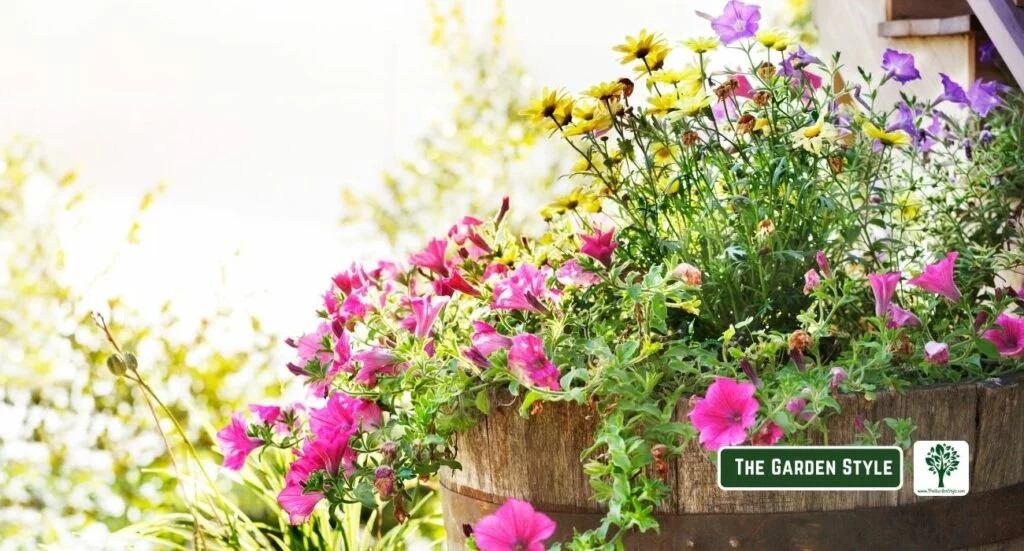
- Beautiful – Full color seed packets of popular flowers including Crackerjack Marigolds, Envy Zinnias, Powder Puff China Aster, Cape Daisy, and Candy Stripe Cosmos. Enjoy outside in the garden and indoors as cut flowers.

- Colorful Mix – Dwarf petunias in shades of red, purple, blue, and white. The 12″ tall plants a cascading habit, which make a delightful container display outdoors.

Partial-Shade Flowers to Grow in Pots
For optimal growth, choose flowers that thrive in spots receiving only filtered sunlight or direct sunlight for 1-4 hours per day. Here is a combination of easy flowers to grow in a partial-shade garden.
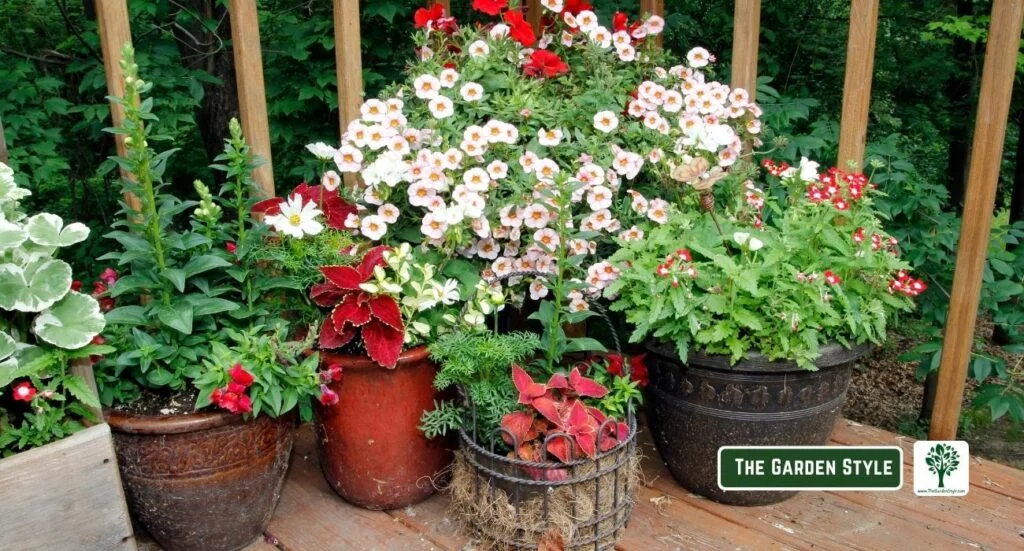
- Begonia
- Calibrachoa (Million Bells)
- Forget-me-nots
- Hydrangeas
- Red corn poppies
- Shirley poppies
- Snapdragons
- Impatiens
- Pansies
Begonias, Impatiens and Pansies are relatively short in height and compact-size, allowing them to be combined effectively with taller flowers like Forget-me-nots, Snapdragons, and Poppies, in a pot situated in a partial-shade garden. These are my favorite flowers that are easy to grow from seeds in containers for a shaded garden.
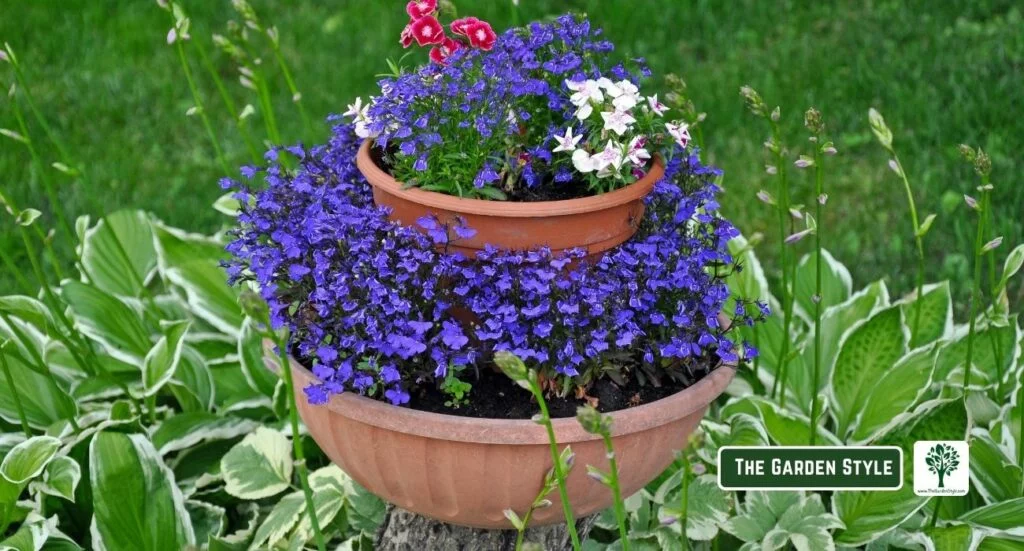
- 100% Pure, Non-GMO Seeds – No fillers, favorites only! Includes 27 easy-to-grow species: Cornflower…

Companion Planting for Arranging Flowers in Pots
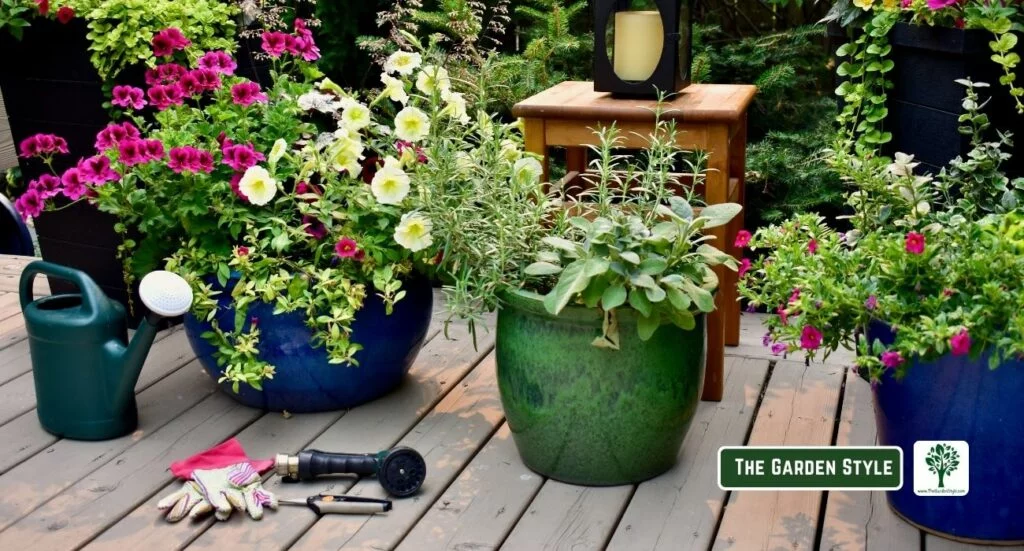
Herbs, vegetables, ornamental grasses, and trailing plants are great companion plants that will thrive when planted with any of the 20 easy flowers to grow in pots and planters.
Herbs and Vegetables
Consider combining your flowers with herbs or compact vegetable varieties for a beautiful and productive container garden. Small pepper plants and some herbs such as mint and basil make excellent companions for many flowering plants.
Ornamental Grasses
Ornamental grasses can add texture and height to your potted displays. Their airy plumes complement the blooms of your flowers and provide visual interest even when the flowers are not in bloom.
Trailing Plants
Trailing plants like sweet potato vines, ivy, or wave petunias can spill over the sides of your pots, adding a cascading effect and softening the edges of your containers.
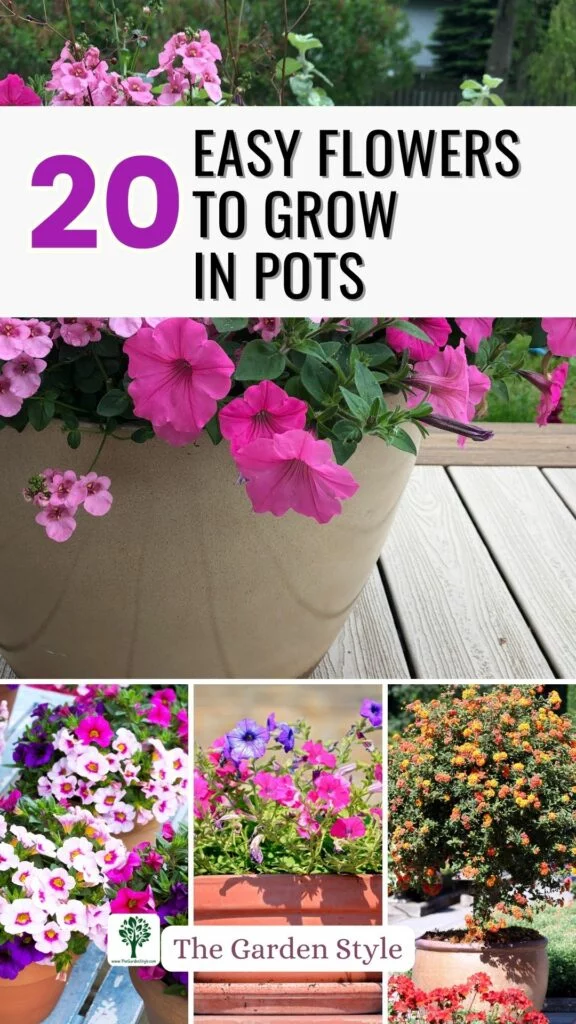
If you want a little more challenging, arrange thriller, filler, and spiller plants using the following technique.

Essential Tips for Growing Flowers in Containers
So, I guess now you have an idea of what flowers you prefer to combine and grow outdoors. Let’s continue with a few tips and tricks to grow them successfully, whether you prefer to grow them from seeds or planting seedlings. These set-up tips will help you to establish a perfect flower garden.


Choosing the Right Pot: Pot Size and Material
When selecting a pot for your flowers, consider the size and drainage. Larger pots are better for bigger plants, while smaller varieties can thrive in more compact containers.
As a general rule, opt for pots that are at least 8-12 inches (20-30 cm approx.) wide and deep.
When selecting pots for outdoor flower gardening, consider materials that are durable, weather-resistant (especially if freezing temperatures during winter), and provide adequate drainage. Some of the best materials for outdoor flower pots include:
- Terracotta: Traditional and porous, providing good airflow to roots. However, it’s susceptible to cracking when exposed to freezing temperatures, especially if moisture is present in the pot.
- Concrete or Cement: Sturdy and long-lasting, ideal for large plants. Generally durable and resistant to freezing, although extreme fluctuations in temperature may cause cracking over time.
- Ceramic or Glazed Pottery: Offers aesthetic appeal and comes in various colors and designs. While visually pleasing, ceramic or glazed pottery can be prone to cracking in freezing temperatures, mainly if water accumulates and expands when it freezes.
- Fiberglass: Lightweight, durable, and resistant to cracking or fading. Fiberglass is resistant to freezing and less likely to crack compared to materials like terracotta or ceramic.
- Metal (such as galvanized steel or aluminum): Metal is modern and sturdy, suitable for contemporary settings. It is generally resistant to freezing and less susceptible to damage from temperature fluctuations.
- Plastic: Lightweight, inexpensive, and available in various colors and sizes. Plastic is resistant to freezing and less likely to crack, making it a good option for cold climates, although it may not be as aesthetically pleasing as other options.
- Wood (such as cedar or teak): Wood is natural and attractive, but it may require maintenance to prevent rotting. Wood can withstand freezing temperatures, although some maintenance may be required to prevent deterioration over time.
Plastic, terra cotta, and ceramic pots are all suitable options, but make sure they have adequate drainage holes to prevent waterlogging.
- 2 PLANTER SHELVES INCLUDED – This planter set comes with planter shelves featuring drainage holes, which offer the choice of elevating your plant and saving some soil. **Please note that this set only includes 2 versatile planter shelves and they can also be adapted as bottom trays.
If you are wondering if these flowers are suitable for a garden bed, let me tell you they are perfect to create a flower garden bed. Just be sure to follow the main care tips to keep them thriving.
Saucer for Growing Potted Flowers
Growing flowers in pots has many benefits, especially in a full-sun garden. Besides helping protect the surface underneath, saucers act as temporary reservoirs for any drained water. This allows the plant’s roots to reabsorb any excess moisture from the saucer over time instead of being lost to drainage. It also prevents the soil from drying out too quickly.
Moreover, during heavy watering or rains, saucers catch any soil that may get dislodged and washed out of the drainage holes.
Stackable planters are an ingenious solution for cultivating a beautiful container garden filled with vibrant flowers. With their space-saving design and convenience, they’re a must-have for any gardening enthusiast.
Soil Preparation: Potting Soil Mix
The key to success with potted flowers is using a high-quality, well-draining potting mix. Avoid using garden soil, which can become compacted and poorly drained in pots. Look for mixes that contain ingredients like peat moss, perlite, and compost to ensure proper aeration and moisture retention.
If re-using an old pot soil mix, don’t forget to add compost or slow-release fertilizer to the potting mix to provide nutrients for your plants.
- Grows Plants Twice as Big vs. unfed plants
- Feeds up to 6 months
- More blooms for more color vs. unfed plants
If you’re planning to create a potted herb garden and grow edible flowers, you might consider opting for an organic potting mix soil designed for outdoor use, such as the one recommended below. This mix contains components that release plant food slowly, providing nourishment for up to 3 months.
- ALL-NATURAL MIX: Burpee Organic Premium Potting Mix is formulated with plant food & coconut coir to promote seed & root growth and healthy flower, vegetable & herb plants. OMRI Listed for organic use. This premium mix releases essential nutrients immediately.
Watering and Fertilizing
Potted plants dry out more quickly than those in the ground, so regular watering is essential. Check the soil moisture daily and water when the top inch or two feels dry.
Fertilize your potted flowers every few weeks with a balanced, water-soluble fertilizer rich in phosphorus to encourage blooming. Here is my favorite organic option, which is also suitable for promoting the flowering of fruit trees and citrus trees.
- Feed all bulbs, tubers, corms and rhizomes
- Made with 100% organic and natural ingredients
- Superior blend of fish bone meal, alfalfa meal, feather meal, soft rock phosphate and mined potassium sulfate
Sunlight Requirements
Pay attention to the sunlight requirements of your chosen flowers. Some, like petunias and zinnias, thrive in full sun, while others, like begonias and impatiens, prefer partial shade. Adjust the location of your pots accordingly.
Pruning and Deadheading
Regular pruning and deadheading (removing spent blooms) can encourage more profuse flowering and keep your plants looking tidy.
To promote healthy growth, pinch back leggy growth and remove any dead or damaged foliage. When you “pinch back” a plant, you remove the growing tip of a stem or shoot, which encourages lateral growth and results in a bushier appearance.
Caring for Flowers Growing in Pots and Planters
Watering
Consistent watering is crucial for the health and vitality of potted flowers. Check the soil moisture regularly by sticking your finger into the soil up to the second knuckle. Water when the top inch or two of soil feels dry.
Fertilizing
Feed your potted flowers every two to four weeks with a balanced, water-soluble fertilizer to replenish essential nutrients. Follow the product’s instructions for proper dosage.
Deadheading
Deadheading, a process of regularly removing spent blooms, encourages more flowers to form and extends the blooming period. Simply pinch or cut off the faded flowers, taking care not to damage any buds.
Overwintering
In cold climates, tender annuals like petunias and zinnias may need to be overwintered indoors. Before the first frost, move them to a sunny spot inside and water sparingly. They may continue blooming for several more weeks.
Frequently Asked Questions
Let’s examine some frequently asked questions when gardeners decide to grow any of these 20 easy flowers in pots, planters, or garden beds.
Water your potted flowers when the top inch or two of the soil feels dry to the touch. The frequency will depend on factors like the pot size, plant type, and weather conditions, but most potted flowers need watering every few days during the growing season.
Most of the easy flowers mentioned here prefer full sun (at least 6 hours of direct sunlight per day), but impatiens thrive in shady conditions. Pay attention to each plant’s sun requirements and position your pots accordingly.
Absolutely! Hanging baskets are a great way to add color and interest to your outdoor space, and many of the flowers listed here, like petunias and calibrachoa, are well-suited for hanging baskets.
If you notice roots growing out of the drainage holes or the plant becomes root-bound, it’s time to transplant to a larger pot. Early spring is the best time for re-potting most annual flowers.
Look for a high-quality, well-draining potting mix specifically formulated for containers. A big mistake is using garden soil for pots and planters. Garden soil becomes compacted and poorly drained in pots. Consider adding compost or slow-release fertilizer to the potting mix to provide nutrients for your plants.
The ideal time to plant flowers in pots varies depending on your climate and the specific plant varieties. In general, spring and early summer are good times to plant most annual and perennial flowers. Nevertheless, you can cultivate certain cool-weather annuals, such as pansies and snapdragons, during autumn, which will yield early spring blossoms.
Final Thoughts Regarding These 20 Easy Flowers to Grow in Pots
Growing flowers in pots is a delightful and accessible way to bring color, fragrance, and beauty into your living space. With suitable soil, sunlight, and care, many varieties of flowers can thrive in containers, offering a rewarding and therapeutic gardening experience. Whether you’re a seasoned green thumb or a budding gardener, the easy flowers we’ve explored in this article are sure to bring you joy and success in your potted garden endeavors. So, grab your pots, potting mix, and seeds, and let the blooms begin!
